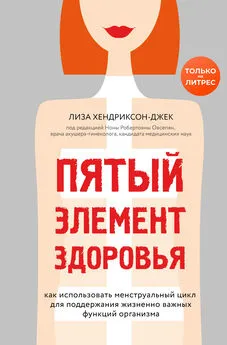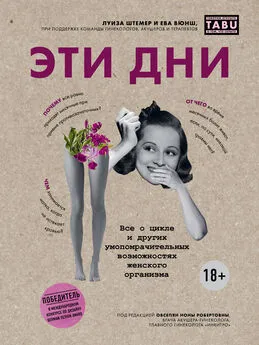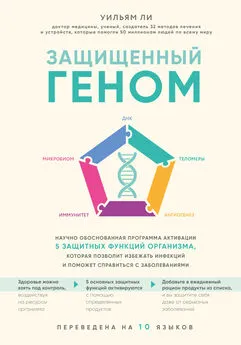Лиза Хендриксон-Джек - Пятый элемент здоровья. Как использовать менструальный цикл для поддержания жизненно важных функций организма
- Название:Пятый элемент здоровья. Как использовать менструальный цикл для поддержания жизненно важных функций организма
- Автор:
- Жанр:
- Издательство:Литагент 5 редакция
- Год:2020
- Город:Москва
- ISBN:978-5-04-104425-1
- Рейтинг:
- Избранное:Добавить в избранное
-
Отзывы:
-
Ваша оценка:
Лиза Хендриксон-Джек - Пятый элемент здоровья. Как использовать менструальный цикл для поддержания жизненно важных функций организма краткое содержание
«Почти» – потому что у женщин есть пятый показатель здоровья, на который, к сожалению, все еще мало кто обращает внимание, – это менструальный цикл. Короткий или длинный, регулярный или непредсказуемый – цикл может быть очень разным, и каждый его параметр, каждое изменение служат индикатором той или иной проблемы в организме. Планируете вы беременность или нет, овуляция имеет значение для поддержания здоровья.
Автор этой книги расскажет, что именно влияет на состояние менструального цикла, и научит вас составлять его график для максимально точного и удобного отслеживания различных изменений и контроля здоровья.
Пятый элемент здоровья. Как использовать менструальный цикл для поддержания жизненно важных функций организма - читать онлайн бесплатно ознакомительный отрывок
Интервал:
Закладка:
78. Balercia, Giancarlo, Fabrizio Mosca, Franco Mantero, Marco Boscaro, Antonio Mancini, Giuseppe Ricciardo-Lamonica, and GianPaolo Littarru. “Coenzyme Q10 supplementation in infertile men with idiopathic asthenozoospermia: an open, uncontrolled pilot study.” Fertility and Sterility 81, no. 1 (2004): 93–98.
79. Lafuente, Rafael, Mireia González-Comadrán, Ivan Solà, Gemma López, Mario Brassesco, Ramón Carreras, and Miguel A. Checa. “Coenzyme Q10 and male infertility: a meta-analysis.” Journal of Assisted Reproduction and Genetics 30, no. 9 (2013): 1147–1156; Safarinejad, Mohammad Reza. “Efficacy of coenzyme Q10 on semen parameters, sperm function and reproductive hormones in infertile men.” The Journal of Urology 182, no. 1 (2009): 237–248.
80. Safarinejad, Mohammad Reza. “The effect of coenzyme Q10 supplementation on partner pregnancy rate in infertile men with idiopathic oligoasthenoteratozoospermia: an open-label prospective study.” International Urology and Nephrology 44, no. 3 (2012): 689–700.
81. Cyrus, Ali, Ali Kabir, Davood Goodarzi, and Mehrdad Moghimi. “The effect of adjuvant vitamin C after varicocele surgery on sperm quality and quantity in infertile men: a double blind placebo controlled clinical trial.” International Brazilian Journal of Urology 41, no. 2 (2015): 230–238; Akmal, Mohammed, J. Q. Qadri, Noori S. Al-Waili, Shahiya Thangal, Afrozul Haq, and Khelod Y. Saloom. “Improvement in human semen quality after oral supplementation of vitamin C.” Journal of Medicinal Food 9, no. 3 (2006): 440–442.
82. Keskes-Ammar, L., N. Feki-Chakroun, T. Rebai, Z. Sahnoun, H. Ghozzi, S. Hammami, K. Zghal, H. Fki, J. Damak, and A. Bahloul. “Sperm oxidative stress and the effect of an oral vitamin E and selenium supplement on semen quality in infertile men.” Archives of Andrology 49, no. 2 (2003): 83–94.
83. Safarinejad, M.R. “Effect of omega-3 polyunsaturated fatty acid supplementation on semen profile and enzymatic anti-oxidant capacity of seminal plasma in infertile men with idiopathic oligoasthenoteratospermia: a double-blind, placebo-controlled, randomised study.” Andrologia 43, no. 1 (2011): 38–47; Hosseini, Banafshe, Mahdieh Nourmohamadi, Shima Hajipour, Mohsen Taghizadeh, Zatollah Asemi, Seyed Ali Keshavarz, and Sadegh Jafarnejad. “The effect of omega-3 fatty acids, EPA, and/or DHA on male infertility: a systematic review and meta-analysis.” Journal of Dietary Supplements (2018): 1–12.
84. Lerchbaum, Elisabeth, and Barbara Obermayer-Pietsch. “Mechanisms in endocrinology: vitamin D and fertility: a systematic review.” European Journal of Endocrinology 166, no. 5 (2012): 765–778; Blomberg Jensen, Martin, Poul J. Bjerrum, Torben E. Jessen, John E. Nielsen, Ulla N. Joensen, Inge A. Olesen, Jørgen H. Petersen, Anders Juul, Steen Dissing, and Niels Jørgensen. “Vitamin D is positively associated with sperm motility and increases intracellular calcium in human spermatozoa.” Human Reproduction 26, no. 6 (2011): 1307–1317.
85. Safarinejad, Mohammad Reza, and Shiva Safarinejad. “Efficacy of selenium and/or N-acetyl-cysteine for improving semen parameters in infertile men: a double-blind, placebo controlled, randomized study.” The Journal of Urology 181, no. 2 (2009): 741–751; Lenzi, Andrea, Paolo Sgro, Pietro Salacone, Donatella Paoli, Barbara Gilio, Francesco Lombardo, Maria Santulli, Ashok Agarwal, and Loredana Gandini. “A placebo-controlled double-blind randomized trial of the use of combined l-carnitine and l-acetyl-carnitine treatment in men with asthenozoospermia.” Fertility and Sterility 81, no. 6 (2004): 1578–1584.
86. Bretherick, Karla L., Nichole Fairbrother, Luana Avila, Sara H.A. Harbord, and Wendy P. Robinson. “Fertility and aging: do reproductive-aged Canadian women know what they need to know?” Fertility and Sterility 93, no. 7 (2010): 2162–2168.
87. Hendrickson-Jack, Lisa. “FFP 109 | The Reality of Aging & Fertility | IVF & Assisted Reproductive Technology | The Future of Fertility Treatments | Dr. Marjorie Dixon.” Fertility Friday Podcast. Podcast Audio, November 25, 2016. fertilityfriday.com/109
88. Allen, N.C., C.M. Herbert, W.S. Maxson, B. Jane Rogers, Michael Peter Diamond, and A. Colston Wentz. “Intrauterine insemination: a critical review.” Fertility and Sterility 44, no. 5 (1985): 569–580.
89. Там же; Kumar, Naina, and Amit Kant Singh. “Trends of male factor infertility, an important cause of infertility: A review of literature.” Journal of Human Reproductive Sciences 8, no. 4 (2015): 191–196.
90. Schorsch, M., R. Gomez, T. Hahn, J. Hoelscher-Obermaier, R. Seufert, and C. Skala. “Success rate of inseminations dependent on maternal age? An analysis of 4246 insemination cycles.” Geburtshilfe und Frauenheilkunde 73, no. 8 (2013): 808–811.
91. Там же.
92. Al-Fozan, Haya, Maha Al-Khadouri, Seang Lin Tan, and Togas Tulandi. “A randomized trial of letrozole versus clomiphene citrate in women undergoing superovulation.” Fertility and Sterility 82, no. 6 (2004): 1561–1563; Mitwally, Mohamed F.M., and Robert F. Casper. “Use of an aromatase inhibitor for induction of ovulation in patients with an inadequate response to clomiphene citrate.” Fertility and Sterility 75, no. 2 (2001): 305–309.
93. Fouda, Usama M., and Ahmed M. Sayed. “Extended letrozole regimen versus clomiphene citrate for superovulation in patients with unexplained infertility undergoing intrauterine insemination: a randomized controlled trial.” Reproductive Biology and Endocrinology 9, no. 1 (2011): 84.
94. Hilgers, T.W., K.D. Daly, A.M. Prebil, and S.K. Hilgers. “Cumulative pregnancy rates in patients with apparently normal fertility and fertility-focused intercourse.” The Journal of Reproductive Medicine 37, no. 10 (1992): 864–866.
95. Stanford, Joseph B., George L. White Jr., and Harry Hatasaka. “Timing intercourse to achieve pregnancy: current evidence.” Obstetrics & Gynecology 100, no. 6 (2002): 1333–1341; Gnoth, C, D. Godehardt, E. Godehardt, P. Frank– Herrmann, and G. Freundl. “Time to pregnancy: results of the German prospective study and impact on the management of infertility.” Human Reproduction 18, no. 9 (2003): 1959–1966.
96. Whitelaw, W. James. “The cervical cap self-applied in the treatment of severe oligospermia.” Fertility and Sterility 31, no. 1 (1979): 86–87.
97. Flierman, Paul A., Hendrikus V. Hogerzeil, and Douwe J. Hemrika. “A prospective, randomized, cross-over comparison of two methods of artificial insemination by donor on the incidence of conception: intracervical insemination by straw versus cervical cap.” Human Reproduction 12, no. 9 (1997): 1945–1948; Nachtigall, Robert D., Nacia. Faure, and Robert H. Glass. “Artificial insemination of husband’s sperm.” Fertility and Sterility 32, no. 2 (1982): 404–410; Coulson, C., E.A. McLaughlin, S. Harris, W.C.L. Ford, and M.G.R. Hull. “Randomized controlled trial of cervical cap with intracervical reservoir versus standard intracervical injection to inseminate cryopreserved donor semen.” Human Reproduction 11, no. 1 (1996): 84–87.
98. Diamond, Michael P., Cathy Christianson, James F. Daniell, and Anne Colston Wentz. “Pregnancy following use of the cervical cup for home artificial insemination utilizing homologous semen.” Fertility and Sterility 39, no. 4 (1983): 480–484.
99. Corson, S.L., F.R. Batzer, C. Otis, and D. Fee. “The cervical cap for home artificial insemination.” The Journal of Reproductive Medicine 31, no. 5 (1986): 349–352.
100. Centers for Disease Control and Prevention, American Society for Reproductive Medicine, Society for Assisted Reproductive Technology. 2015 Assisted Reproductive Technology National Summary Report. Atlanta (GA): US Dept of Health and Human Services; 2017.
101. Там же.
102. Klipstein, Sigal, Meredith Regan, David A. Ryley, Marlene B. Goldman, Michael M. Alper, and Richard H. Reindollar. “One last chance for pregnancy: a review of 2,705 in vitro fertilization cycles initiated in women age 40 years and above.” Fertility and Sterility 84, no. 2 (2005): 435–445.
103. Cohen, Matthew A., Steven R. Lindheim, and Mark V. Sauer. “Donor age is paramount to success in oocyte donation.” Human Reproduction 14, no. 11 (1999): 2755–2758.
104. Kim, Chung-Hoon, and Gyun-Ho Jeon. “Fertility preservation in female cancer patients.” ISRN Obstetrics and Gynecology (2012): 1–6.
105. Hendrickson-Jack, Lisa. “FFP 225 | Egg Freezing and Cryopreservation | Fertility Preservation | Valerie Landis.” Fertility Friday Podcast. Podcast Audio, October 12, 2018. fertilityfriday.com/225.
106. Pierce, Nicole, and Edgar Mocanu. “Female age and assisted reproductive technology.” Global Reproductive Health 3, no. 2 (2018): e9.
Глава 18
1 Hendrickson-Jack, Lisa. “FFP 104 | Birth Control Pills From Your Doctor’s Perspective | Why Your Physician Isn’t Looking at the Root Cause | Alternative Medicine for Women | Dr. Miranda Naylor.” Fertility Friday Podcast. Podcast Audio, November 4, 2016. fertilityfriday.com/104.
2. Hendrickson-Jack, Lisa. “FFP 194 | How Effective Are Fertility Awareness-Based Methods… Really? | Dr. Marguerite Duane, MD.” Fertility Friday Podcast. Podcast Audio, April 13, 2018. fertilityfriday.com/194.
3. World Health Organization Department of Reproductive Health and Research (WHO/RHR) and Johns Hopkins Bloomberg School of Public Health/Center for Communication Programs (CCP), Knowledge for Health Project. Family Planning: A Global Handbook for Providers (2018 update). Baltimore and Geneva: CCP and WHO, 2018: 325–326.
4. Sussman, Steve, Thomas W. Valente, Louise A. Rohrbach, Silvana Skara, and Mary Ann Pentz. “Translation in the health professions: converting science into action.” Evaluation & the Health Professions 29, no. 1 (2006): 7–32.
Приложение
1. Malpuech-Brugère, Corinne, Wojciech Nowacki, Maryvonne Daveau, Elyett Gueux, Christine Linard, Edmond Rock, Jean-Pierre Lebreton, Andrzej Mazur, and Yves Rayssiguier. “Inflammatory response following acute magnesium deficiency in the rat.” Biochimica et Biophysica Acta (BBA) – Molecular Basis of Disease 1501, no. 2 (2000): 91–98; Volpe, Stella Lucia. “Magnesium in disease prevention and overall health.” Advances in Nutrition: An International Review Journal 4, no. 3 (2013): 378S–383S; Alaimo, Katherine, Margaret A. McDowell, R.R. Briefel, A.M. Bischof, C.R. Caughman, C.M. Loria, and C.L. Johnson. “Dietary intake of vitamins, minerals, and fiber of persons ages 2 months and over in the United States: third national health and nutrition examination survey, phase 1, 1988–91.” Advance Data 258 (1994): 1–28; Marier, J.R. “Magnesium content of the food supply in the modern-day world.” Magnesium 5, no. 1 (1985): 1–8.
2. Walker, Ann F., Georgios Marakis, Samantha Christie, and Martyn Byng. “Mg citrate found more bioavailable than other Mg preparations in a randomised, double-blind study.” Magnesium Research 16, no. 3 (2003): 183–191; Murray, Michael T., and Joseph E. Pizzorno. (2012). The Encyclopedia of Natural Medicine, 3rd edition. London: Simon & Schuster, 896–897.
3. Chandrasekaran, Navin Chandrakanth, Christopher Weir, Sumaya Alfraji, Jeff Grice, Michael S. Roberts, and Ross T. Barnard. “Effects of magnesium deficiency – more than skin deep.” Experimental Biology and Medicine 239, no. 10 (2014): 1280–1291.
4. Watkins, K., and P.D. Josling. “A pilot study to determine the impact of transdermal magnesium treatment on serum levels and whole body CaMg ratios.” The Nutrition Practitioner (2010); Wells, Katie, “How to make magnesium oil | Wellness Mama.” Wellness Mama®. Accessed May 9, 2017. wellnessmama.com/5804/make-your-own-magnesium-oil.
Читать дальшеИнтервал:
Закладка:









